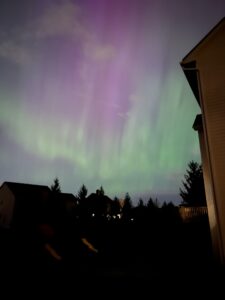On May 10, 2024, at a latitude of only 43° 5′ 23″ N, while hanging out in my backyard, I saw the northern lights.

I took pictures like this one.
I posted on social media.
I bragged to some friends.
I said, how amazing!
Then I asked myself, what are the northern lights anyway?
Here’s the tiny bit I learned, presented in oversimplified fashion.
The Sun
The sun is an average-sized star, just one among hundreds of billions in the Milky Way, not to mention the Universe. That said, to us, it’s a very important one.
Located about 93 million miles from Earth, the modest star is a large ball of gas and plasma, the latter being a superheated state of matter consisting of positively and negatively charged particles. This plasma is constantly being emitted from the sun’s outermost atmosphere (corona) into the solar system, resulting in the so-called solar wind.
Every 11 years or so, based on a solar cycle, a solar maximum translates into a strong solar wind, allowing relative southerners like me to write about what comes below.
The Earth
Orbiting the aforementioned star is the earth, a random rock, albeit one that holds a special place in our hearts. As metals are among the numerous elements found on Earth, the planet generates its own magnetic field. And surrounding the planet, consisting largely of gases, is a multilayered atmosphere.
So What Are the Northern Lights?
As the solar wind approaches Earth, the planet’s magnetic field directs the charged particles toward the poles. When the charged particles interact with the gases in Earth’s atmosphere, atoms (mostly nitrogen and oxygen) enter a state of excitation. This added energy must then be released in the form of light.
The light show, when seen in regions near the North Pole, is referred to as the northern lights (aurora borealis) and, when seen near the South Pole, the southern lights (aurora australis).
As above, during a solar maximum, the same phenomenon can be appreciated in areas quite distant from the poles. Aside from providing photo-worthy moments, these events can have less marvelous consequences, at times interfering with satellites, communication systems, and power grids. (I briefly lost power the next morning.)
A Couple Songs
After learning the science, I ended the luminous night with something far less cerebrally taxing—a soundtrack.
“Northern Lights” by St. Vincent
If you’re one of those ultra-pensive, indie-rock types who scares your friends with your deep and/or weird thoughts, this track is for you.
“Die A Happy Man” by Thomas Rhett
And if you’re more the whiskey-drinking, have-fun type who occasionally looks at the sky and says something not all that deep, this one’s for you.
2 Responses
Educative, but I was looking for some satire somewhere.
Thank you. Haha…I saved the satire for future work.